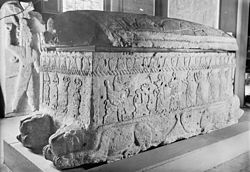Memory of the World Register – Arab States
Appearance

The first inscriptions on the UNESCO Memory of the World International Register were made in 1997.[1] By creating a compendium of the world's documentary heritage—manuscripts, oral traditions, audio-visual materials, library and archive holdings—the program aims to promote the preservation, digitization, and dissemination of documentary materials.[2]
As of 2023, 494 documentary heritages have been included in the register.[3] Of these, seventeen properties were nominated by countries from the region of the Arab States. They include religious and secular manuscripts, texts carved on stone, maps, and historical archives.
Image gallery
[edit]-
Rock inscriptions at Jabal Ikmah, Saudi Arabia
-
Frontispiece from a Mamluk Quran manuscript, Egyptian National Library
-
Commemorative stela of Nahr el-Kalb, Lebanon
-
The Beggar at the Mosque from the Persian Illustrated and Illuminated Manuscripts of the Egyptian National Library
List by country/territory
[edit]Notes
[edit]^ Names and spellings provided are based on the official list released by the Memory of the World Programme.
References
[edit]- ^ "Third Meeting of the International Advisory Committee of the Memory of the World Programme". UNESCO Memory of the World Programme. 1997. Retrieved 2025-02-18.
- ^ Banda, Fackson (2021). "Sustainable development and documentary heritage: towards a conceptual framework". In Banda, Fackson (ed.). Towards Sustainable Preservation and Accessibility of Documentary Heritage. UNESCO. p. 11. ISBN 978-92-3-100496-4.
- ^ "64 new inscriptions on UNESCO's Memory of the World Register". UNESCO. 24 May 2023. Retrieved 2025-02-18.
- ^ "Al – Mustamlah Min Kitab Al – Takmila". UNESCO Memory of the World. Retrieved 2025-02-14.
- ^ "First Summit Meeting of the Non-Aligned Movement Archives". UNESCO Memory of the World. Retrieved 2025-02-18.
- ^ "Memory of the Suez Canal". UNESCO Memory of the World Programme. Retrieved 2025-02-18.
- ^ "The National Library of Egypt's Collection of Mamluk Qur'an Manuscripts". UNESCO Memory of the World Programme. Retrieved 2025-02-14.
- ^ "Deeds of Sultans and Princes". UNESCO Memory of the World Programme. Retrieved 2025-02-14.
- ^ "Persian Illustrated and Illuminated Manuscripts". UNESCO Memory of the World Programme. Retrieved 2025-02-14.
- ^ "The Phoenician Alphabet". UNESCO Memory of the World Programme. Retrieved 2025-02-14.
- ^ "Commemorative stela of Nahr el-Kalb, Mount Lebanon". UNESCO Memory of the World Programme. Retrieved 2025-02-14.
- ^ "Kitab al-ibar, wa diwan al-mobtadae wa al-khabar". UNESCO Memory of the World Programme. Retrieved 2025-02-14.
- ^ "Manuscript of al- Zahrāwīsu". UNESCO Memory of the World Programme. Retrieved 2025-02-14.
- ^ "Maden Al Asrar Fi Elm Al Behar Manuscript". UNESCO Memory of the World Programme. Retrieved 2025-02-14.
- ^ "Earliest Islamic (Kufic) inscription". UNESCO Memory of the World Programme. Retrieved 2025-02-14.
- ^ "Arabian Chronicles in Stone: Jabal Ikmah". UNESCO Memory of the World Programme. Retrieved 2025-02-14.
- ^ "Privateering and the international relations of the Regency of Tunis in the 18th and 19th centuries". UNESCO Memory of the World Programme. Retrieved 2025-02-14.
- ^ "The Abolition of Slavery in Tunisia 1841-1846". UNESCO Memory of the World Programme. Retrieved 2025-02-14.
- ^ "The Music holdings in Baron Rodolphe d'Erlanger's archives (1910-1932)". UNESCO Memory of the World Programme. Retrieved 2025-02-14.




